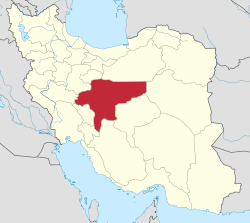Baba Ghassem Mausoleum
| Baba Ghassem Mausoleum | |
|---|---|
آرامگاه باباقاسم | |
 The mausoleum in 2018 | |
| Religion | |
| Affiliation | Islam |
| Ecclesiastical or organizational status | Mausoleum |
| Status | Active |
| Location | |
| Location | Esfahan, Isfahan province |
| Country | Iran |
Location of the complex in Iran | |
 | |
| Geographic coordinates | 32°40′23″N 51°41′12″E / 32.67306°N 51.68667°E |
| Architecture | |
| Type | Islamic architecture |
| Style | |
| Completed |
|
| Materials | Bricks; adobe; plaster; tiles |
 An undated black-and-white photograph of the mausoleum | |
| Official name | Baba Ghassem Mausoleum |
| Type | Built |
| Designated | 6 January 1932 |
| Reference no. | 100 |
| Conservation organization | Cultural Heritage, Handicrafts and Tourism Organization of Iran |
| [1] | |
The Baba Ghassem Mausoleum (Persian: آرامگاه باباقاسم; Arabic: ضريح بابا قاسم), also known as the Baba Qasem Mausoleum, is a mausoleum in the Ebn-e Sina district of the city of Esfahan, in the province of Isfahan, Iran.[2] The building was completed in 1431 CE, during the Ilkhanid period;[3] and is located to the north of Jameh Mosque of Isfahan.[2]
The complex was added to the Iran National Heritage List on 6 January 1932, administered by the Cultural Heritage, Handicrafts and Tourism Organization of Iran.
History
[edit]Baba Ghassem, also known as Baba Qasim al-Isfahani, was a religious teacher and a Sufi mystic. He would teach at a madrasah in Isfahan.[4][5] Not much is known about his life. When he died, he was buried next to the madrasah. In the years 1340-1341, his student, Sulayman ibn Abu'l Husayn ibn Talut al-Damghani, built a mausoleum over his grave with a conical dome.[5][3] During the reign of Safavid ruler Safi of Persia, the building was renovated by a local patron.[6]
Architecture
[edit]Rectangular in shape, the building is topped by a conical dome that has eight layers.[6] On the base of the dome, the words Allah-Tauba, Nabi Muhammad, Din-i-Islam, and Imam Ali are visible in a repeated manner.[4] The entrance has a shabestan with an arch above full of muqarnas.[6]
Inside the building, there is a wooden door with Thuluth inscriptions on it, leading to the domed tomb chamber.[7] Under the dome, two inscriptions made with mosaic tiles can be seen. One of them is written around the nave (below the dome's base) and contains phrases from the Qur'an.[6] The other inscription written below the first inscription refers to the name of the founder of the mausoleum.[6]
Inside the mausoleum, the grave of Baba Ghassem is located underneath the dome enclosed by a wooden cage-like structure.[4] A standalone grave is also present, and it is dedicated to an unknown individual named "Mirza Ali" who died in 1577.[4][7][6]
Gallery
[edit]-
Entrance to the mausoleum
-
The inside of the dome
See also
[edit]References
[edit]- ^ "Imamzadah Baba Qasim". ArchNet.org. n.d. Retrieved May 23, 2025.
- ^ a b Yaghoubi, Hosseyn (2004). Beheshti, Arash (ed.). Rāhnamā ye Safar be Ostān e Esfāhān [Travel Guide for the Province Isfahan] (in Persian). Rouzane. p. 118. ISBN 9643342182.
- ^ a b سایت, مدیریت (January 4, 2019). آرامگاه باباقاسم. اینجا اصفهان (in Persian). Retrieved December 5, 2023.
- ^ a b c d مقبره بابا قاسم در اصفهان | شهر اصفهان | استان اصفهان| سفربانک. www.safarbank.net (in Persian). Retrieved December 5, 2023.
- ^ a b نوروز ۱۴۰۱ فرصتی برای بازدید از مقبره باباقاسم. ایمنا (in Persian). March 30, 2022. Retrieved December 5, 2023.
- ^ a b c d e f سایت, مدیریت (January 4, 2019). آرامگاه باباقاسم. اینجا اصفهان [injaisfahan.ir] (in Persian). Retrieved December 5, 2023.
- ^ a b "نوروز ۱۴۰۱ فرصتی برای بازدید از مقبره باباقاسم". ایمنا (in Persian). March 30, 2022. Retrieved December 5, 2023.
Further reading
[edit]- Pope, Arthur Upham (1977). "The Fourteenth Century". In Pope, Arthur Upham; Ackerman, Phyllis (eds.). A Survey of Persian Art. Tehran: Soroush Press. pp. 1052–1102.
- Wilber, Donald N. (1969). The Architecture of Islamic Iran. New York: Greenwood Press. p. 182.
External links
[edit]![]() Media related to Baba Qasem Mausoleum at Wikimedia Commons
Media related to Baba Qasem Mausoleum at Wikimedia Commons
- 14th-century religious buildings and structures in Iran
- Buildings and structures completed in 1431
- Domes in Iran
- Ilkhanid architecture
- Mausoleums in Isfahan
- Mausoleums, shrines and tombs on the Iran National Heritage List
- Octagonal buildings in Iran
- Religious buildings and structures with domes
- Safavid architecture in Iran








